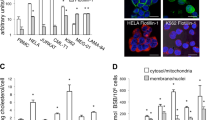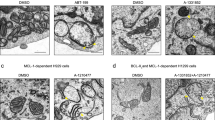Abstract
Hexadecylphosphocholine (HePC) is an anticancer agent whose effect has been shown to involve apoptosis induction but the signaling pathways leading to apoptosis remain to be elucidated. We show here that HePC induces activation of caspase-9, -3, and -8 via the intrinsic pathway, release of cytochrome c, activation and relocation of Bax to the mitochondria as well as the cleavage of Bid. Moreover, a lysosomal pathway characterized by partial lysosomal rupture, cathepsin B activation and relocation from lysosomes to the cytosol, is involved in HePC-induced apoptosis. A cathepsin B/L inhibitor partially suppresses caspase activation and apoptosis induction, indicating signaling between lysosomes and mitochondria. Conversely, the pancaspase inhibitor Q-VD-OPH inhibits lysosomal rupture, but only at early time points, suggesting that immediate lysosomal rupture involves caspases. Overexpression of Bcl-2, an anti-apoptotic protein known to prevent mitochondrial dysfunction, totally abrogates lysosomal destabilization and cell death.








Similar content being viewed by others
References
Gajate C, Mollinedo F (2002) Biological activities, mechanisms of action and biomedical prospect of the antitumor ether phospholipid ET-18-OCH(3) (edelfosine), a proapoptotic agent in tumor cells. Curr Drug Metab 3:491–525
Unger C, Sindermann H, Peukert M, Hilgard P, Engel J, Eibl H (1992) Hexadecylphosphocholine in the topical treatment of skin metastases in breast cancer patients. Prog Exp Tumor Res 34:153–159
Clive S, Gardiner J, Leonard RC (1999) Miltefosine as a topical treatment for cutaneous metastases in breast carcinoma. Can Chem Pharm 44(Suppl):S29–S30
Terwogt JM, Mandjes IA, Sindermann H, Beijnen JH, ten Bokkel Huinink WW (1999) Phase II trial of topically applied miltefosine solution in patients with skin-metastasized breast cancer. Br J Cancer 79:1158–1161
Leonard R, Hardy J, van Tienhoven G et al (2001) Randomized, double-blind, placebo-controlled, multicenter trial of 6% miltefosine solution, a topical chemotherapy in cutaneous metastases from breast cancer. J Clin Oncol 19:4150–4159
Dummer R, Krasovec M, Roger J, Sindermann H, Burg G (1993) Topical administration of hexadecylphosphocholine in patients with cutaneous lymphomas: results of a phase I/II study. J Am Acad Dermatol 29:963–970
Croft SL, Barrett MP, Urbina JA (2005) Chemotherapy of trypanosomiases and leishmaniasis. Trends Parasitol 21:508–512
Sundar S, Rai M (2005) Treatment of visceral leishmaniasis. Expert Opin Pharmacother 6:2821–2829
Eibl H, Unger C (1990) Hexadecylphosphocholine: a new and selective antitumor drug. Cancer Treat Rev 17:233–242
Jendrossek V, Handrick R (2003) Membrane targeted anticancer drugs: potent inducers of apoptosis and putative radiosensitisers. Curr Med Chem Anticancer Agents 3:343–353
Berkovic D, Wernicke JH, Fleer EA (2003) Effects of etherlipid analogs on cell membrane functions. J Exp Ther Oncol 3:185–193
Mollinedo F, Fernandez-Luna JL, Gajate C et al (1997) Selective induction of apoptosis in cancer cells by the ether lipid ET-18-OCH3 (Edelfosine): molecular structure requirements, cellular uptake, and protection by Bcl-2 and Bcl-X(L). Cancer Res 57:1320– 1328
Ruiter GA, Verheij M, Zerp SF, van Blitterswijk WJ (2001) Alkyl-lysophospholipids as anticancer agents and enhancers of radiation-induced apoptosis. Int J Radiat Oncol Biol Phys 49:415–419
Engelmann J, Henke J, Willker W et al (1996) Early stage monitoring of miltefosine induced apoptosis in KB cells by multinuclear NMR spectroscopy. Anticancer Res 16:1429–1439
Henke J, Engelmann J, Kutscher B et al (1999) Changes of intracellular calcium, fatty acids and phospholipids during miltefosine-induced apoptosis monitored by fluorescence- and 13C NMR-spectroscopy. Anticancer Res 19:4027–4032
Rybczynska M, Spitaler M, Knebel NG, Boeck G, Grunicke H, Hofmann J (2001) Effects of miltefosine on various biochemical parameters in a panel of tumor cell lines with different sensitivities. Biochem Pharmacol 62:765–772
Haase R, Wieder T, Geilen CC, Reutter W (1991) The phospholipid analogue hexadecylphosphocholine inhibits phosphatidylcholine biosynthesis in Madin-Darby canine kidney cells. FEBS Lett 288:129–132
Geilen CC, Wieder T, Reutter W (1992) Hexadecylphosphocholine inhibits translocation of CTP:choline-phosphate cytidylyltransferase in Madin-Darby canine kidney cells. J Biol Chem 267:6719–6724
Wieder T, Orfanos CE, Geilen CC (1998) Induction of ceramide-mediated apoptosis by the anticancer phospholipid analog, hexadecylphosphocholine. J Biol Chem 273:11025–11031
Wang YZ, Chang YB, Xing C, Fu D (1998) The interference effects of hexadecylphosphocholine on proliferation and membrane phospholipid metabolism in human myeloid leukemia cell lines. Int J Tissue React 20:101–107
Ruiter GA, Zerp SF, Bartelink H, van Blitterswijk WJ, Verheij M (2003) Anti-cancer alkyl-lysophospholipids inhibit the phosphatidylinositol 3-kinase-Akt/PKB survival pathway. Anticancer Drugs 14:167–173
Gajate C, Santos-Beneit A, Modolell M, Mollinedo F (1998) Involvement of c-Jun NH2-terminal kinase activation and c-Jun in the induction of apoptosis by the ether phospholipid 1-O-octadecyl-2-O-methyl-rac-glycero-3-phosphocholine. Mol Pharmacol 53:602–612
Ruiter GA, Zerp SF, Bartelink H, van Blitterswijk WJ, Verheij M (1999) Alkyl-lysophospholipids activate the SAPK/JNK pathway and enhance radiation-induced apoptosis. Cancer Res 59:2457–2463
Jendrossek V, Kugler W, Erdlenbruch B, Eibl H, Lang F, Lakomek M (2001) Erucylphosphocholine-induced apoptosis in chemoresistant glioblastoma cell lines: involvement of caspase activation and mitochondrial alterations. Anticancer Res 21:3389–3396
Jendrossek V, Muller I, Eibl H, Belka C (2003) Intracellular mediators of erucylphosphocholine-induced apoptosis. Oncogene 22:2621–2631
Handrick R, Rudner J, Muller I, Eibl H, Belka C, Jendrossek V (2005) Bcl-2 mediated inhibition of erucylphosphocholine-induced apoptosis depends on its subcellular localisation. Biochem Pharmacol 70:837–850
Cabaner C, Gajate C, Macho A, Munoz E, Modolell M, Mollinedo F (1999) Induction of apoptosis in human mitogen-activated peripheral blood T-lymphocytes by the ether phospholipid ET-18-OCH3: involvement of the Fas receptor/ligand system. Br J Pharmacol 127:813–825
Gajate C, Mollinedo F (2001) The antitumor ether lipid ET-18-OCH(3) induces apoptosis through translocation and capping of Fas/CD95 into membrane rafts in human leukemic cells. Blood 98:3860–3863
Gajate C, Del Canto-Janez E, Acuna AU et al (2004) Intracellular triggering of Fas aggregation and recruitment of apoptotic molecules into Fas-enriched rafts in selective tumor cell apoptosis. J Exp Med 200:353–365
Hengartner MO (2000) The biochemistry of apoptosis. Nature 407:770–776
Scaffidi C, Fulda S, Srinivasan A et al (1998) Two CD95 (APO-1/Fas) signaling pathways. Embo J 17:1675–1687
Li H, Zhu H, Xu CJ, Yuan J (1998) Cleavage of BID by caspase 8 mediates the mitochondrial damage in the Fas pathway of apoptosis. Cell 94:491–501
Yin XM (2000) Signal transduction mediated by Bid, a pro-death Bcl-2 family proteins, connects the death receptor and mitochondria apoptosis pathways. Cell Res 10:161–167
Costantini P, Jacotot E, Decaudin D, Kroemer G (2000) Mitochondrion as a novel target of anticancer chemotherapy. J Natl Cancer Inst 92:1042–1053
Kroemer G, Reed JC (2000) Mitochondrial control of cell death. Nat Med 6:513–519
Debatin KM, Poncet D, Kroemer G (2002) Chemotherapy: targeting the mitochondrial cell death pathway. Oncogene 21:8786–8803
van Loo G, Saelens X, van Gurp M, MacFarlane M, Martin SJ, Vandenabeele P (2002) The role of mitochondrial factors in apoptosis: a Russian roulette with more than one bullet. Cell Death Differ 9:1031–1042
Saelens X, Festjens N, Vande Walle L, van Gurp M, van Loo G, Vandenabeele P (2004) Toxic proteins released from mitochondria in cell death. Oncogene 23:2861–2874
Acehan D, Jiang X, Morgan DG, Heuser JE, Wang X, Akey CW (2002) Three-dimensional structure of the apoptosome: implications for assembly, procaspase-9 binding, and activation. Mol Cell 9:423–432
Li P, Nijhawan D, Budihardjo I et al (1997) Cytochrome c and dATP-dependent formation of Apaf-1/caspase-9 complex initiates an apoptotic protease cascade. Cell 91:479–489
Kroemer G (1997) The proto-oncogene Bcl-2 and its role in regulating apoptosis. Nat Med 3:614–620
Chao DT, Korsmeyer SJ (1998) BCL-2 family: regulators of cell death. Annu Rev Immunol 16:395–419
Vander Heiden MG, Thompson CB (1999) Bcl-2 proteins: regulators of apoptosis or of mitochondrial homeostasis? Nat Cell Biol 1: E209–216
Letai A, Bassik MC, Walensky LD, Sorcinelli MD, Weiler S, Korsmeyer SJ (2002) Distinct BH3 domains either sensitize or activate mitochondrial apoptosis, serving as prototype cancer therapeutics. Cancer Cell 2:183–192
Ferri KF, Kroemer G (2001) Organelle-specific initiation of cell death pathways. Nat Cell Biol 3: E255–E263
Guicciardi ME, Leist M, Gores GJ (2004) Lysosomes in cell death. Oncogene 23:2881–2890
Turk B, Stoka V, Rozman-Pungercar J et al (2002) Apoptotic pathways: involvement of lysosomal proteases. Biol Chem 383:1035–1044
Jaattela M, Cande C, Kroemer G (2004) Lysosomes and mitochondria in the commitment to apoptosis: a potential role for cathepsin D and AIF. Cell Death Differ 11:135–136
Turk B, Turk D, Turk V (2000) Lysosomal cysteine proteases: more than scavengers. Biochim Biophys Acta 1477:98–111
Leist M, Jaattela M (2001) Triggering of apoptosis by cathepsins. Cell Death Differ 8:324–326
Renvoize C, Roger R, Moulian N, Bertoglio J, Breard J (1997) Bcl-2 expression in target cells leads to functional inhibition of caspase-3 protease family in human NK and lymphokine-activated killer cell granule-mediated apoptosis. J Immunol 159:126–134
Mosmann T (1983) Rapid colorimetric assay for cellular growth and survival: application to proliferation and cytotoxicity assays. J Immunol Methods 65:55–63
Zdolsek JM, Olsson GM, Brunk UT (1990) Photooxidative damage to lysosomes of cultured macrophages by acridine orange. Photochem Photobiol 51:67–76
Cirman T, Oresic K, Mazovec GD et al (2004) Selective disruption of lysosomes in HeLa cells triggers apoptosis mediated by cleavage of Bid by multiple papain-like lysosomal cathepsins. J Biol Chem 279:3578–3587
Wood DE, Newcomb EW (2000) Cleavage of Bax enhances its cell death function. Exp Cell Res 256:375–382
Cao X, Deng X, May WS (2003) Cleavage of Bax to p18 Bax accelerates stress-induced apoptosis, and a cathepsin-like protease may rapidly degrade p18 Bax. Blood 102:2605–2614
Vancompernolle K, Van Herreweghe F, Pynaert G et al (1998) Atractyloside-induced release of cathepsin B, a protease with caspase-processing activity. FEBS Lett 438:150–158
Paquet C, Sane AT, Beauchemin M, Bertrand R (2005) Caspase- and mitochondrial dysfunction-dependent mechanisms of lysosomal leakage and cathepsin B activation in DNA damage-induced apoptosis. Leukemia 19:784–791
Zhao M, Eaton JW, Brunk UT (2001) Bcl-2 phosphorylation is required for inhibition of oxidative stress-induced lysosomal leak and ensuing apoptosis. FEBS Lett 509:405–412
Berkovic D, Luders S, Goeckenjan M, Hiddemann W, Fleer EA (1997) Differential regulation of phospholipase A2 in human leukemia cells by the etherphospholipid analogue hexadecylphosphocholine. Biochem Pharmacol 53:1725–1733
Kagedal K, Johansson AC, Johansson U et al (2005) Lysosomal membrane permeabilization during apoptosis—involvement of Bax? Int J Exp Pathol 86:309–321
Acknowledgments
We are grateful to FRM (Fondation pour la Recherche Médicale) for providing financial support to Caroline Paris. We thank Valérie Nicolas for her excellent assistance in confocal microscopy. INSERM U749 is an “Equipe labellisée par la Ligue Nationale contre le Cancer”.
Author information
Authors and Affiliations
Corresponding author
Rights and permissions
About this article
Cite this article
Paris, C., Bertoglio, J. & Bréard, J. Lysosomal and mitochondrial pathways in miltefosine-induced apoptosis in U937 cells. Apoptosis 12, 1257–1267 (2007). https://doi.org/10.1007/s10495-007-0052-1
Published:
Issue Date:
DOI: https://doi.org/10.1007/s10495-007-0052-1




